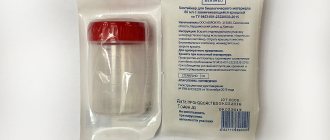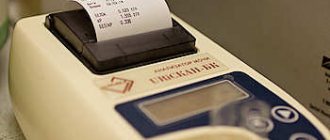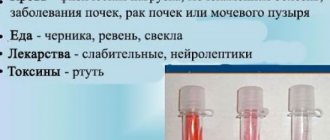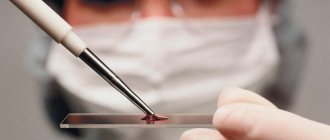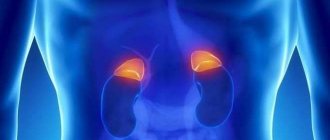Principle of the method
As a result of the Sulkovich test, it becomes clear whether the baby has hypocalcemia or hypercalcemia. The causes of both diseases include an unbalanced diet and (or) the presence of pathological changes in the body.
A urine test according to Sulkovich in an infant is necessary when prescribing vitamin D for preventive purposes. There is a special need for such measures for children born in autumn or winter, that is, during those periods of time when the sun shines less intensely. Natural luminary is a natural source of fat-soluble vitamin, which belongs to the steroid type prohormones, whose functions include the exchange and absorption of Ca and P.
These processes are vital for humans because their body is not able to independently produce cholecalciferol (D3) and ergocalciferol (D2). These forms of vitamin D are not the only ones; there are also D1, D4 and D5. The formation of these elements is stimulated by ultraviolet rays that hit the skin. Vitamin D can enter the body through food.
An accurate determination of the daily dose for an infant is necessary to restore balance in the event of a lack of the “solar” element. Moreover, it should not cause excess vitamin levels in the body, as this is also fraught with problems. The Sulkovich reaction during diagnostics gives a result that cannot be considered unambiguous. After all, it can be influenced by many factors, for example, the consumption of prohibited products before collecting biological material.
If the results of the Sulkovich test reveal a lack of calcium, then rickets is suspected. What it is? This is a disease that causes bones to form improperly. Excessive vitamin D levels cause hypercalcemia, which provokes hormonal imbalances, damage to the circulatory and skeletal systems, gastrointestinal tract and central nervous system, as well as diseases of unknown etiology, for example, sarcoidosis.
Why is hypercalcemia dangerous?
The condition in which the body finds itself when there is excess calcium is very dangerous. It is accompanied by many diseases, for example, hypervitaminosis, hormonal disorders, sarcoidosis, tumors, etc. Excess calcium leads to damage to all organs and systems, but the bones, central nervous system, intestines and blood vessels are most affected. The pathological condition is expressed by impaired consciousness (up to coma), muscle weakness or tension, arterial hypertension, decreased heart rate, the appearance of kidney stones, and deterioration of glomerular filtration. Since calcium is absorbed in the gastrointestinal tract, an increase in its level leads to digestive disorders, including nausea, vomiting, and constipation. In the skeletal system, tissue compaction occurs, which is accompanied by movement disorders and pain.
Indications for the test
The Sulkowicz test is a method that helps to recognize pathologies affecting the genitourinary, endocrine, digestive and nervous systems. Oncologists also consult him. This is due to the fact that high-quality differential diagnosis without the Sulkovich test is hardly possible.
Indications for testing in adults and children differ slightly. For children, this laboratory test is prescribed if there is suspicion of:
Recommended topic:
Decoding urine analysis in children
- pancreatitis;
- granules in the lymphatic system, kidneys, liver;
- tremor of the limbs;
- tuberculosis;
- Wilson's disease;
- hypoparathyroidism.
For adults, the list is somewhat longer; sarcoidosis and tetany are added. For cancer patients, the benefit of such screening is expressed in the detection of tumors of the producing type, which can arise in any organ of the human body.
Reasons for deviations
A high concentration of calcium in urine may indicate the presence of problems in the body such as:
- hyperparathyroidism is a disease of the endocrine system, which is based on an increased level of parathyroid hormone productivity;
- sarcoidosis;
- Paget's disease (bone problems);
- disorders of the kidneys;
- hypercalcemia - exceeding the permissible level of Ca in the blood;
- poor quality formations;
- excess vitamin D in the body;
- Fanconi syndrome (caused by dysfunction of the renal canals, resulting in poor calcium absorption);
- the presence of stones in internal organs;
- leukemia;
- diabetes.
A low concentration of calcium in urine indicates:
- problems with digestion of food, causing diarrhea and vomiting;
- problems with the kidneys (impaired filtration);
- lack of vitamin D by the body;
- hypoparathyroidism.
- X-ray of the spine - what does it show? Find the answer here!
- Ultrasound of axillary lymph nodes shows what
- What does an MRI of the cervical-thoracic spine show?
- What does an oak from a vein show?
Collection of biological material for analysis
Urine for the Sulkowicz test must be collected, with the opportunity to immediately deliver it to the laboratory. Otherwise, after 2 hours it will become unsuitable for research. Collecting biological material from an infant and newborn is quite difficult. The most accurate result is determined by the Sulkovich test using urine accumulated over a day, but it is impossible to carry out a similar procedure with a child who cannot understand what exactly is required of him.
Urine collection
How to collect urine from a baby? To implement this plan, urinals were developed. These are devices that are attached to the child’s genitals using Velcro, without causing pain.
When prescribing the Sulkovich test for the first time, a one-time urine collection is allowed; subsequent laboratory testing requires daily biological material. This is because the second analysis is intended to clarify the meaning obtained earlier.
Why is calcium assessment so important?
The importance of calcium for the human body is difficult to overestimate. Most of this trace element is found in teeth and bones. Disorders in calcium metabolism can be detected using blood or urine tests. The Sulkovich test makes it possible to determine the degree of this disorder. The amount of calcium released from the body can be used to judge the condition of the kidneys and metabolism in bone tissue.
Monitoring urine calcium levels is very important, especially in infants. This is due to the fact that a lack of this microelement can lead to improper formation of bone tissue. That is, the structure of the bone tissue becomes more fragile, which subsequently leads to skeletal deformation.
Excessive levels of calcium in children's urine can cause bone destruction or the development of seizures. This is very dangerous and requires immediate medical treatment. In addition, excess calcium, deposited in the skeletal system, leads to slower bone growth.
The main use of the Sulkowicz test is in pediatrics, since almost immediately after birth, doctors prescribe vitamin D for children to prevent the development of rickets.
Rickets is a very common disease that is dangerous. Vitamin D is needed to regulate phosphorus-calcium metabolism in the human body. If there is not enough calcium, then softening of the bones can occur, which negatively affects the baby’s skeleton. If there is an acute deficiency or absence of calcium, then rickets often develops. Newborns are at risk of serious health complications that cannot always be eliminated.
If rickets develops in childhood, then over time, the child receives high bone compliance or crooked limbs. Often even the child’s head becomes square in shape, and the fontanel does not heal for a very long time.
When a doctor prescribes the use of vitamin D, he must accurately take into account the daily amount of the norm, since otherwise a complication will arise that leads to the development of pathologies.
It is very important to monitor the calcium level in an infant, since excess, as well as deficiency, has an extremely negative effect on health. Bones cannot grow properly, and pathological processes with them lead to irreversible processes.
The baby must have a normal calcium level; in order to achieve it, you need to adjust your diet or resort to medications.
Preparing for the test
Before donating urine, you need to familiarize yourself with the rules for preparing for the Sulkovich test. The main place in them is occupied by the list of prohibited foods, ignoring which leads to an incorrect value for the obtained indicator. You should stop consuming the following foods and drinks three days before your test.
- Fermented milk and dairy products.
- Greenery.
- Chocolate.
- Pastries made from butter or puff pastry.
- Sweet dishes.
- Fruits, particularly bananas.
- Mineral water.
- Alcohol.
- Strong tea
- Juices.
- Coffee (regardless of type).
You also need to forget about physical activity for a while and, if possible, avoid stressful situations. Women should postpone the Sulkowicz test if they have started their menstrual periods.
How to collect the analysis correctly?
When directly collecting biological material, you need to follow the following algorithm:
Recommended topic:
Urine analysis during pregnancy
- Buy a sterile urine container with a screw-on lid.
- Carry out hygienic treatment of the genitals using regular soap, which does not contain additives, including fragrances.
- Collect urine from the second and third streams (the first is not necessary).
- Close the container without touching the inside. It is treated with a preservative to preserve liquid.
- Deliver the urine to the laboratory for a Sulkowicz test.
The main condition is to comply with the time of urine collection. This should happen in the morning. You should not eat or drink before the procedure. The fence rules are mandatory for both adults and children.
The boy should place a pre-prepared container under the stream, and the girl should simply place it in the pot. It is advisable to first show the child the device and explain why it is needed. Then everything will be done correctly and without unnecessary emotions.
Carrying out analysis
Sulkovich's test is carried out as follows: a reagent containing ethanedioic acid is added to the patient's urine; in everyday life it is called oxalic acid. Urine is a waste product of the metabolic process, excess fluid and minerals. The interaction of ethanedioic acid with the latter, in particular with calcium, leads to the formation of a precipitate (turbidity), on the basis of which the result of the Sulkovich test is determined.
Its interpretation can be carried out in different ways, it directly depends on the specialist. Therefore, the data obtained during decoding are taken into account as relative indicators. The Sulkovich test is always supplemented with other laboratory tests: biochemical analysis of urine and blood. Detection of creatinine and other elements will clarify the clinical picture.
What is Sulkowicz's test?
A laboratory test of urine, which can be used to determine the presence of calcium in urine, is called the Sulkowicz test. It shows how much of a given element is excreted from the body. Its overestimated or underestimated value indicates the presence of a number of diseases or that it is necessary to pay attention to the daily diet. Typically, this type of test is prescribed for infants who are suspected of having rickets.
The main reasons why a doctor may refer a patient for analysis using the Sulkowicz method are:
- intake of vitamins A and D in quantities exceeding the norm;
- assumption of the presence of rickets;
- the likelihood of developing Besnier disease;
- possible presence of oncological formations;
- suspected hypothyroidism or hyperthyroidism.
Decoding the results
Sulkovich's reaction is deciphered visually. The visual determination of turbidity is expressed using points, and the result is recorded using pluses. Insoluble sediment (if present) receives a score from 1 to 4. The average value of the indicator is considered the reference value. Obtaining such a result from the Sulkovich test indicates the absence of deviations in the amount of vitamin D and refutes suspicions of the presence of hypercalcemia and hypocalcemia.
Score decoding of the Sulkovich test:
- 0 points – lack of calcium in the body, a bad indicator. Possible rickets in a child and hypoparathyroidism in an adult. There is a possibility of a malignant tumor that has metastasized, pathological absorption, convulsive syndrome, hypoalbuminemia, and kidney problems. The patient is registered, special attention is paid to children.
- From 1 to 2 points – a normal ratio of minerals, characterized by maintaining balance. No additional action is required.
- From 3 to 4 points – exceeding the upper limit of the reference value, presumably hypercalcemia or increased influence of the parathyroid gland. The possibility of further detection of osteoporosis, sarcoidosis, colitis, diabetes mellitus, and leukemia is noted.
If it is impossible to determine the result, it is recorded as doubtful, and the test is repeated after 3-4 days. It is also possible to get an erroneous result. It can be both positive and negative. It is affected by:
- Taking medications. An increase is caused by antacids, vitamin D itself (multivitamins containing it), Furosemide and glucocorticoids. The opposite effect is possible when using Indomethacin, oral contraceptives and Aspirin.
- Inclusion of prohibited foods in the diet. The consequences of this step are different: heart problems, loss of concentration, nausea, vomiting, polyuremia, general weakness.
After performing the Sulkovich test, the attending physician prescribes additional laboratory tests. If they confirm the result obtained earlier, then he selects treatment, during which the effect of the measures taken is monitored. This is only possible using the same Sulkovich test. In the absence of the expected effect, the complex of therapeutic measures is revised, that is, other medications and procedures are selected.
The patient is required to strictly comply with all prescriptions, timely take control tests and inform the specialist about changes in well-being. You should also eat right, because eating prohibited foods will significantly reduce the benefits of the treatment measures taken.
Interpretation of urine analysis according to Sulkovich
To evaluate, you need to take morning urine. A very important condition is to take tests on an empty stomach, otherwise a high-quality diagnostic study will not be carried out. The interpretation of the analysis is determined by the level of urine turbidity. If the result is negative, it indicates the presence of hypoparathyroidism. Thus, both calcium and vitamin D are insufficient in the human body. Hypocalcemia may also be present, but such a diagnosis is determined subject to parallel blood testing for reliability.
A negative result may mean:
- lack of ergocalciferol in the human body;
- disruption of the functioning of the thyroid gland and decreased production of hormones;
- defect in magnesium metabolism;
- metastases of a malignant tumor in the prostate gland that have penetrated into the bones;
- chronic and acute kidney failure, which is characterized by the release of diluted urine;
- use of anti-inflammatory non-steroidal medications, diuretics containing hydrochlorothiazide;
- a hemotest determined intolerance to products containing calcium.
One or two points, that is, + or ++, is the established average norm in urine, indicating low calcium content.
Three and four points (+++ or ++++) indicate excessive release of calcium from the body during bladder emptying. For example, when a patient has hyperparathyroidism, approximately 200 milligrams of this macronutrient are washed out of his body in the urine in 24 hours. Deviations from the norm require additional diagnostics and effective therapy.

